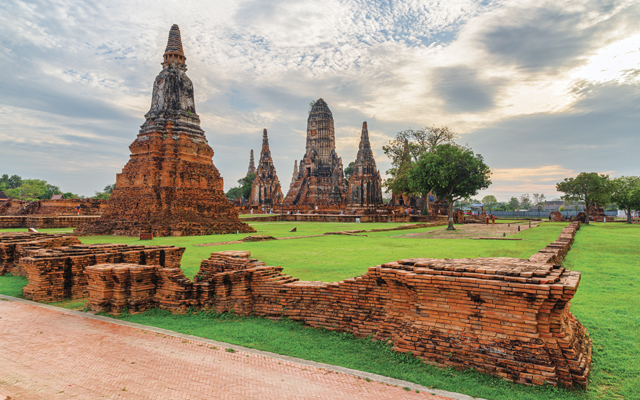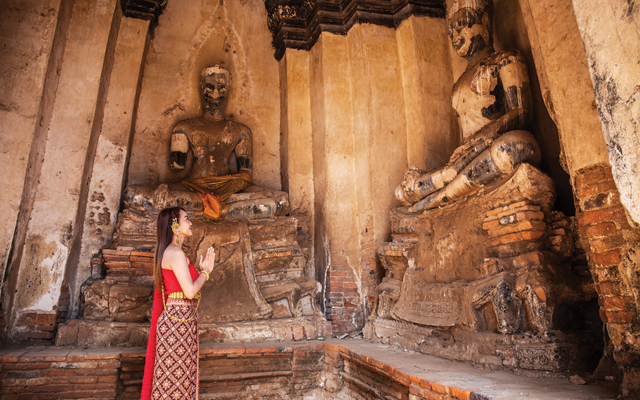Ayutthaya is actively shaping the future of Thai tourism through a blend of historical charm, modern amenities, and pop culture appeal
When the city of Ayutthaya fell in 1767, the reigning monarch who was to become King Rama I, transposed the city layout of Ayutthaya to the riverside of the Chao Phraya in Rattanakosin, Bangkok, which is why the ancient city ruins – one of Thailand’s first UNESCO World Heritage sites – are oddly reminiscent of Bangkok’s old town.
However, Ayutthaya is not just a relic of the past.

One of the key factors contributing to Ayutthaya’s resurgence is its role in contemporary pop culture. The city has frequently served as the backdrop for Thai historical dramas on popular local TV channels. Notably, soap opera Buppaesanniwat (Love Destiny) has reignited interest in Ayutthaya.
Key locations like Wat Chaiwatthanaram have become must-visit sites for fans eager to immerse themselves in the show’s historical setting, with numerous cafés and shops popping up around it. Mayura’s House café nearby even offers Thai costume- and Thai temple-themed ice pops.
In Bangkok, Ayutthaya and the ancient time period is celebrated through creative initiatives such as Hotel Indigo Bangkok Wireless Road, which allows guests to borrow Thai apparel for their trips to Ayutthaya as part of their Borrowed By Hotel Indigo programme, or Sense Of Thai near the Grand Palace in Bangkok, popular for daily rental of costumes for such trips.
This trend has become so popular that visitors who arrive in Ayutthaya without a costume can rent one from local shops for just a few hundred Thai baht. Numerous street shops across from Wat Chaiwatthanaram offer visitors a chance to dress up for an Ayutthaya-era photoshoot.
Global pop icon Lisa Manobal of South Korean girl group Blackpink has also played a significant role in boosting Ayutthaya’s allure. Her recent family visit to the city in summer 2023, where she shared photos of herself in traditional Thai attire at a temple ruin, sparked a wave of interest among her international fan base, introducing Ayutthaya to a new generation of travellers.
Ayutthaya’s culinary scene – already famed among foodies and families in the domestic market for long-weekend trips – has also gained significant recognition, particularly since the province was integrated into the Michelin Guide Thailand in 2022. A wonderful addition is Suriyan Chandra restaurant, located in a 130-year-old rice mill, which helps travellers relive the days of the city’s river commerce with dining cruises on restored teakwood rice barges.
Furthermore, the addition of Centara Ayutthaya – the first hotel by an international hospitality group in Ayutthaya – has made a significant impact. The hotel, now the tallest and largest in the city, features the city’s first rooftop bar, offering 360-degree views of the historical city and its surrounding rice fields stretching as far as the eye can see – a view previously unseen by visitors.

It is connected to the Central Ayutthaya mall, which boasts the Plern Nakhon indoor market on the ground floor, where numerous local eats are sold.
“The design of Centara Ayutthaya blends modernity with tradition, incorporating Ayutthaya-coloured brick motifs in the tile floors and carpets, and Thai-style wooden windows in the rooms,” noted Chen Thipvarodom, general manager of the hotel.
“But it’s not just about the design. We’ve also worked to highlight Ayutthaya’s rich culinary heritage in our food and beverage offerings.”
Chen continued: “The success of Centara Ayutthaya is part of a broader strategy by the Centara Group to replicate this hotel-mall pairing model in Eastern provinces – a model we’ve already successfully executed in places like Udon Thani. This approach caters to a diverse range of travellers – from locals and families enjoying long weekends, to executives from the Eastern Economic Corridor who require long-stay accommodation,” he shared.
As Thailand continues to promote secondary destinations, Ayutthaya’s strategic location near the Thai capital city is becoming increasingly significant.
“We have tours to Ayutthaya, and, increasingly, we use Ayutthaya as the first station on our trips heading north,” shared Stephan Roemer, CEO of DTH Travel Thailand.
Kim Martin Rasmussen, Thailand general manager for Exo Travel, highlighted Ayutthaya’s low-carbon and sustainable draws with rail-themed travel and cycling activities.
“For the longhaul traveller market, Ayutthaya is often included as an overnight stay on the way from Bangkok and further up north to Ayutthaya; visits tend to be more classic and often done by bike to get around the ruins. For shorthaul travellers, Ayutthaya is seen as a day-trip option with lots of Instagrammable cafés,” he told TTG Asia.
Roemer felt that Ayutthaya was still not unsuitable for groups due to “limited” high-end options.
Travel trends analyst Gary Bowerman opined: “A key challenge for Ayutthaya is in changing perceptions as well as infrastructure. It is widely perceived as a day-trip or coach-trip destination for tourists visiting Bangkok.
“In addition to creating unique, value-added experiences for high-yield travellers that distinguish their Ayutthaya trip – especially in the evenings when the coaches have departed and early mornings before they arrive – there is also the challenge of marketing Ayutthaya as a destination rather than a site of archaeological ruins that people want to cross off their bucket list.”
Tourism consultant Jens Thraenhart concluded: “Ayutthaya has the potential to entice both high-yield travellers and mass tourists. The key is to develop the infrastructure for high-yield travellers to have authentic experiences that will lead to higher spend in local businesses, such as local boutique hotels, quality handicrafts (rather than cheap products made in China), and great local restaurants that celebrate authentic culinary culture.”











